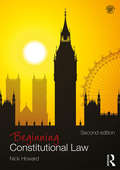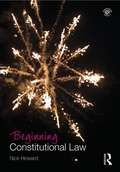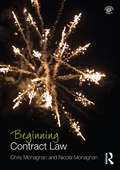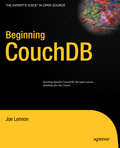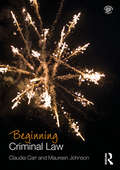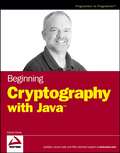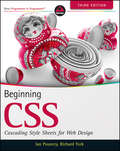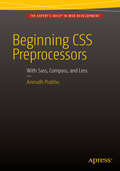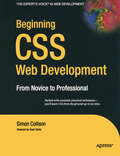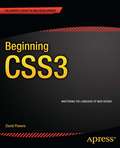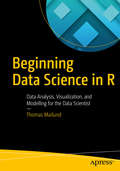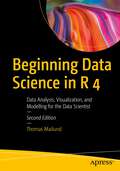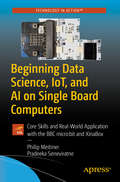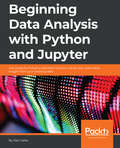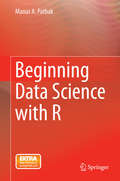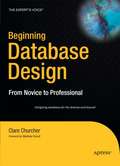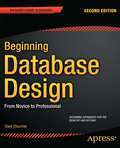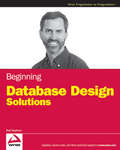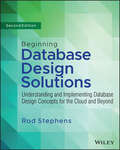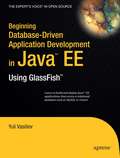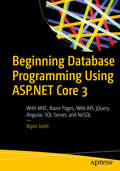- Table View
- List View
Beginning Constitutional Law (Beginning the Law)
by Nick HowardWhether you’re new to higher education, coming to legal study for the first time or just wondering what Constitutional Law is all about, Beginning Constitutional Law is the ideal introduction to help you hit the ground running. Adopting a clear and simple approach with legal vocabulary explained in a detailed glossary avaliable on the companion website, Nick Howard breaks the subject of constitutional law down using practical everyday examples to make it understandable for anyone, whatever their background. Diagrams and flowcharts simplify complex issues, important cases are identified and explained, and on-the- spot questions help you recognise potential issues or debates within the law so that you can contribute in classes with confidence. This second edition has been updated to keep up to date with developments both before and after the 2015 General Election as well as ongoing proposals for reform, including: • The referendum on independence for Scotland, increased devolved powers and the continued threat of the break-up of the Union. • Proposals to repeal the Human Rights Act 1998 and replace it with a British Bill of Rights. • The in/out referendum on EU membership. • Reform of the role and composition of the House of Lords. Beginning Constitutional Law is an ideal first introduction to the subject for LLB, GDL or ILEX and especially international students, those enrolled on distance learning courses or on other degree programmes.
Beginning Constitutional Law (PDF)
by Nick HowardWhether you're new to higher education, coming to legal study for the first time or just wondering what Constitutional Law is all about, Beginning Constitutional Lawis the ideal introduction to help you hit the ground running. Starting with the basics and an overview of each topic, it will help you come to terms with the structure, themes and issues of the subject so that you can begin your Consttitutional Law module with confidence. Adopting a clear and simple approach with legal vocabulary explained in a detailed glossary, Nick Howard breaks the subject of constitutional law down using practical everyday examples to make it understandable for anyone, whatever their background. Diagrams and flowcharts simplify complex issues, important cases are identified and explained and on-the- spot questions help you recognise potential issues or debates within the law so that you can contribute in classes with confidence. Beginning Constitutional Law is an ideal first introduction to the subject for LLB, GDL or ILEX and especially international students, those enrolled on distance learning courses or on other degree programmes.
Beginning Contract Law
by Nicola Monaghan Chris MonaghanWhether you’re new to higher education, coming to legal study for the first time or just wondering what Contract Law is all about, Beginning Contract Law is the ideal introduction to help you hit the ground running. Starting with the basics and an overview of each topic, it will help you come to terms with the structure, themes and issues of the subject so that you can begin your Contract Law module with confidence. Adopting a clear and simple approach with legal vocabulary explained in a detailed glossary, Chris and Nicola Monaghan break the subject of Contract law down using practical everyday examples to make it understandable for anyone, whatever their background. Diagrams and flowcharts simplify complex issues, important cases are identified and explained and on-the- spot questions help you recognise potential issues or debates within the law so that you can contribute in classes with confidence. Beginning Contract Law is an ideal first introduction to the subject for LLB, GDL or ILEX and especially international students, those enrolled on distance learning courses or on other degree programmes.
Beginning Contract Law
by Nicola Monaghan Chris MonaghanWhether you’re new to higher education, coming to legal study for the first time or just wondering what Contract Law is all about, Beginning Contract Law is the ideal introduction to help you hit the ground running. Starting with the basics and an overview of each topic, it will help you come to terms with the structure, themes and issues of the subject so that you can begin your Contract Law module with confidence. Adopting a clear and simple approach with legal vocabulary explained in a detailed glossary, Chris and Nicola Monaghan break the subject of Contract law down using practical everyday examples to make it understandable for anyone, whatever their background. Diagrams and flowcharts simplify complex issues, important cases are identified and explained and on-the- spot questions help you recognise potential issues or debates within the law so that you can contribute in classes with confidence. Beginning Contract Law is an ideal first introduction to the subject for LLB, GDL or ILEX and especially international students, those enrolled on distance learning courses or on other degree programmes.
Beginning CouchDB
by Joe LennonThe new world of cloud computing needs data storage. CouchDB is the scalable, portable, simple database engine that is helping open source cloud architects put their data stores onto a firm foundation. Beginning CouchDB provides the tools to begin using this very powerful database engine without having to pay license fees for the software, or worry about administrator's certifications or vast hardware requirements. This book teaches the fundamentals of one of the most powerful database engines ever created for the price of a good lunch. After reading this book and working through the examples, you'll be able to write your own applications for CouchDB quickly and easily. In-depth, non-intimidating guide to CouchDB and how it differs from similar offerings such as SimpleDB and BigTable, and also how it differs from traditional relational and object-oriented databases such as Oracle, SQL Server, and MySQL. Detailed explanation of how CouchDB works, its suitability for use in distributed environments, the role of Erlang, and other technical topics in a manner that does not obfuscate methods or results. JavaScript is extremely popular as a development language for CouchDB. No Erlang is required, but a little bit can't hurt either. A tutorial-oriented approach to teaching readers how to use CouchDB, featuring many code examples and listings, as well as screenshots where relevant.
Beginning Criminal Law
by Claudia Carr Maureen JohnsonWhether you’re new to higher education, coming to legal study for the first time or just wondering what Criminal Law is all about, Beginning Criminal Law is the ideal introduction to help you hit the ground running. Starting with the basics and an overview of each topic, it will help you come to terms with the structure, themes and issues of the subject so that you can begin your Criminal Law module with confidence. Adopting a clear and simple approach with legal vocabulary explained in a detailed glossary, Claudia Carr and Maureen Johnson break the subject of criminal law down using practical everyday examples to make it understandable for anyone, whatever their background. Diagrams and flowcharts simplify complex issues, important cases are identified and explained and on-the- spot questions help you recognise potential issues or debates within the law so that you can contribute in classes with confidence. Beginning Criminal Law is an ideal first introduction to the subject for LLB, GDL or ILEX and especially international students, those enrolled on distance learning courses or on other degree programmes.
Beginning Criminal Law
by Claudia Carr Maureen JohnsonWhether you’re new to higher education, coming to legal study for the first time or just wondering what Criminal Law is all about, Beginning Criminal Law is the ideal introduction to help you hit the ground running. Starting with the basics and an overview of each topic, it will help you come to terms with the structure, themes and issues of the subject so that you can begin your Criminal Law module with confidence. Adopting a clear and simple approach with legal vocabulary explained in a detailed glossary, Claudia Carr and Maureen Johnson break the subject of criminal law down using practical everyday examples to make it understandable for anyone, whatever their background. Diagrams and flowcharts simplify complex issues, important cases are identified and explained and on-the- spot questions help you recognise potential issues or debates within the law so that you can contribute in classes with confidence. Beginning Criminal Law is an ideal first introduction to the subject for LLB, GDL or ILEX and especially international students, those enrolled on distance learning courses or on other degree programmes.
Beginning Cryptography with Java
by David HookBeginning Cryptography with Java While cryptography can still be a controversial topic in the programming community, Java has weathered that storm and provides a rich set of APIs that allow you, the developer, to effectively include cryptography in applications-if you know how. This book teaches you how. Chapters one through five cover the architecture of the JCE and JCA, symmetric and asymmetric key encryption in Java, message authentication codes, and how to create Java implementations with the API provided by the Bouncy Castle ASN.1 packages, all with plenty of examples. Building on that foundation, the second half of the book takes you into higher-level topics, enabling you to create and implement secure Java applications and make use of standard protocols such as CMS, SSL, and S/MIME. What you will learn from this book How to understand and use JCE, JCA, and the JSSE for encryption and authentication The ways in which padding mechanisms work in ciphers and how to spot and fix typical errors An understanding of how authentication mechanisms are implemented in Java and why they are used Methods for describing cryptographic objects with ASN.1 How to create certificate revocation lists and use the Online Certificate Status Protocol (OCSP) Real-world Web solutions using Bouncy Castle APIs Who this book is for This book is for Java developers who want to use cryptography in their applications or to understand how cryptography is being used in Java applications. Knowledge of the Java language is necessary, but you need not be familiar with any of the APIs discussed. Wrox Beginning guides are crafted to make learning programming languages and technologies easier than you think, providing a structured, tutorial format that will guide you through all the techniques involved.
Beginning CSS: Cascading Style Sheets for Web Design (Wrox Beginning Guides Ser.)
by Ian Pouncey Richard YorkCompletely updated material and new examples show you what CSS can do With the latest versions of Firefox, Safari, Internet Explorer, and other browsers released, CSS is more essential than ever. This beginner guide demonstrates how cascading style sheets can be used to define styles to items in Web pages, rather than format each item individually. Each lesson in this full-color book has been methodically revised to be more concise and efficient, making your learning experience as productive as possible. Covers the latest in CSS, including the new features of Internet Explorer, Firefox, Safari, and Google Chrome Reviews the vast improvements to mobile browsers and how CSS can work with them Provides helpful examples and walks you through real-world solutions to common hurdles Discusses embedded fonts, compatibility tables, and cross-browser bug scenarios Beginning CSS, Third Edition gets you completely up to date so that you can start using CSS in the newest Web and mobile browsers today!
Beginning CSS Preprocessors: With SASS, Compass.js and Less.js
by Anirudh PrabhuLearn how preprocessors can make CSS scalable and easy to maintain. You'll see how to write code in a very clean and scalable manner and use CSS preprocessor features such as variables and looping, which are missing in CSS natively. Reading Beginning CSS Preprocessors will make your life much simpler by showing you how to create reusable chunks of code. In addition to coding enhancements, you’ll also learn to automate processes such as generating image sprites and minifying code.Beginning CSS Preprocessors is your guide for getting started with CSS preprocessors. This book shows you how to use CSS in your day-to-day work and thus be smart and efficient at writing CSS. What are preprocessors What are the known preprocessor frameworksWhat are the features of Sass (Syntactically Awesome Stylesheets)What is Compass (COMPrehensive ASSembler) What is Less (Leaner SS)
Beginning CSS Web Development: From Novice to Professional
by Simon CollisonThere are many books available on CSS, but this one is different — it wastes less time discussing theory, and gets straight to the practical learning, quickly giving readers what they need to know. In addition, it is completely up to date, covering the most modern CSS standards and design techniques. Beyond the CSS essentials, advanced techniques are covered, including accessibility, hacks and filters. The book concludes with a case study, and a CSS reference section to allow the reader to look up required syntax in seconds.
Beginning CSS3
by David PowersBeginning CSS3 teaches you how to style web pages using Cascading Style Sheets (CSS)—the language of web design. Starting from first principles, you’ll learn through a series of practical exercises how to change the default look of HTML tags, adding color, backgrounds, and borders. The book demystifies core concepts, such as the CSS box model and selectors, giving you the confidence and knowledge to create innovative and flexible page layouts. You’ll also learn how to create rounded corners, drop shadows, and gradients without the need for images, using the latest CSS3 techniques.
Beginning Data Science in R: Data Analysis, Visualization, and Modelling for the Data Scientist
by Thomas MailundDiscover best practices for data analysis and software development in R and start on the path to becoming a fully-fledged data scientist. This book teaches you techniques for both data manipulation and visualization and shows you the best way for developing new software packages for R.Beginning Data Science in R details how data science is a combination of statistics, computational science, and machine learning. You’ll see how to efficiently structure and mine data to extract useful patterns and build mathematical models. This requires computational methods and programming, and R is an ideal programming language for this. This book is based on a number of lecture notes for classes the author has taught on data science and statistical programming using the R programming language. Modern data analysis requires computational skills and usually a minimum of programming. What You Will LearnPerform data science and analytics using statistics and the R programming languageVisualize and explore data, including working with large data sets found in big dataBuild an R packageTest and check your codePractice version controlProfile and optimize your codeWho This Book Is ForThose with some data science or analytics background, but not necessarily experience with the R programming language.
Beginning Data Science in R 4: Data Analysis, Visualization, and Modelling for the Data Scientist
by Thomas MailundDiscover best practices for data analysis and software development in R and start on the path to becoming a fully-fledged data scientist. Updated for the R 4.0 release, this book teaches you techniques for both data manipulation and visualization and shows you the best way for developing new software packages for R. Beginning Data Science in R 4, Second Edition details how data science is a combination of statistics, computational science, and machine learning. You’ll see how to efficiently structure and mine data to extract useful patterns and build mathematical models. This requires computational methods and programming, and R is an ideal programming language for this. Modern data analysis requires computational skills and usually a minimum of programming. After reading and using this book, you'll have what you need to get started with R programming with data science applications. Source code will be available to support your next projects as well.Source code is available at github.com/Apress/beg-data-science-r4.What You Will LearnPerform data science and analytics using statistics and the R programming languageVisualize and explore data, including working with large data sets found in big dataBuild an R packageTest and check your codePractice version controlProfile and optimize your codeWho This Book Is ForThose with some data science or analytics background, but not necessarily experience with the R programming language.
Beginning Data Science, IoT, and AI on Single Board Computers: Core Skills and Real-World Application with the BBC micro:bit and XinaBox
by Philip Meitiner Pradeeka SeneviratneLearn to use technology to undertake data science and to leverage the Internet of Things (IoT) in your experimentation. Designed to take you on a fascinating journey, this book introduces the core concepts of modern data science. You'll start with simple applications that you can undertake on a BBC micro:bit and move to more complex experiments with additional hardware. The skills and narrative are as generic as possible and can be implemented with a range of hardware options. One of the most exciting and fastest growing topics in education is data science. Understanding how data works, and how to work with data, is a key life skill in the 21st century. In a world driven by information it is essential that students are equipped with the tools they need to make sense of it all. For instance, consider how data science was the key factor that identified the dangers of climate change -- and continues to help us identify and react to the threats it presents. This book explores the power of data and how you can apply it using hardware you have at hand. You'll learn the core concepts of data science, how to apply them in the real world and how to utilize the vast potential of IoT. By the end, you'll be able to execute sophisticated and meaningful data science experiments - why not become a citizen scientist and make a real contribution to the fight against climate change. There is something of a digital revolution going these days, especially in the classroom. With increasing access to microprocessors, classrooms are are incorporating them more and more into lessons. Close to 5 million BBC micro:bits will be in the hands of young learners by the end of the year and millions of other devices are also being used by educators to teach a range of topics and subjects. This presents an opportunity: microprocessors such as micro:bit provide the perfect tool to use to build 21st century data science skills. Beginning Data Science and IoT on the BBC micro:bit provides you with a solid foundation in applied data science.What You'll Learn · Use sensors with a microprocessor to gather or "create" data · Extract, tabulate, and utilize data it from the microprocessor · Connect a microprocessor to an IoT platform to share and then use the data we collect · Analyze and convert data into information Who This Book Is For Educators, citizen scientists, and tinkerers interested in an introduction to the concepts of IoT and data on a broad scale.
Beginning Data Science with Python and Jupyter: Use powerful tools to unlock actionable insights from data
by Alex GaleaGetting started with data science doesn't have to be an uphill battle. This step-by-step guide is ideal for beginners who know a little Python and are looking for a quick, fast-paced introduction.About This BookGet up and running with the Jupyter ecosystem and some example datasetsLearn about key machine learning concepts like SVM, KNN classifiers and Random ForestsDiscover how you can use web scraping to gather and parse your own bespoke datasetsWho This Book Is ForThis book is ideal for professionals with a variety of job descriptions across large range of industries, given the rising popularity and accessibility of data science. You'll need some prior experience with Python, with any prior work with libraries like Pandas, Matplotlib and Pandas providing you a useful head start.What You Will LearnIdentify potential areas of investigation and perform exploratory data analysisPlan a machine learning classification strategy and train classification modelsUse validation curves and dimensionality reduction to tune and enhance your modelsScrape tabular data from web pages and transform it into Pandas DataFramesCreate interactive, web-friendly visualizations to clearly communicate your findingsIn DetailGet to grips with the skills you need for entry-level data science in this hands-on Python and Jupyter course. You'll learn about some of the most commonly used libraries that are part of the Anaconda distribution, and then explore machine learning models with real datasets to give you the skills and exposure you need for the real world. We'll finish up by showing you how easy it can be to scrape and gather your own data from the open web, so that you can apply your new skills in an actionable context.Style and approachThis book covers every aspect of the standard data-workflow process within a day, along with theory, practical hands-on coding, and relatable illustrations.
Beginning Data Science with R
by Manas A. Pathak“We live in the age of data. In the last few years, the methodology of extracting insights from data or "data science" has emerged as a discipline in its own right. The R programming language has become one-stop solution for all types of data analysis. The growing popularity of R is due its statistical roots and a vast open source package library.The goal of “Beginning Data Science with R” is to introduce the readers to some of the useful data science techniques and their implementation with the R programming language. The book attempts to strike a balance between the how: specific processes and methodologies, and understanding the why: going over the intuition behind how a particular technique works, so that the reader can apply it to the problem at hand. This book will be useful for readers who are not familiar with statistics and the R programming language.
Beginning Database Design: From Novice to Professional
by Clare ChurcherThe problem of how to design a database is commonly encountered by those not specifically trained and practiced in the art. This book, therefore, is written with the lay person in mind. In simple language, the author uses examples from her real-life experience to highlight the types of problems that can result from poor design, to motivate readers to do good design. She then goes on to provide a sound method that readers can follow in order to produce a good design. While focus is on implementing designs in relational databases, the author does not forget those readers who will choose to implement their database in a spreadsheet such as Microsoft Excel.
Beginning Database Design: From Novice to Professional
by Clare ChurcherBeginning Database Design, Second Edition provides short, easy-to-read explanations of how to get database design right the first time. This book offers numerous examples to help you avoid the many pitfalls that entrap new and not-so-new database designers. Through the help of use cases and class diagrams modeled in the UML, you&’ll learn to discover and represent the details and scope of any design problem you choose to attack.Database design is not an exact science. Many are surprised to find that problems with their databases are caused by poor design rather than by difficulties in using the database management software. Beginning Database Design, Second Edition helps you ask and answer important questions about your data so you can understand the problem you are trying to solve and create a pragmatic design capturing the essentials while leaving the door open for refinements and extension at a later stage. Solid database design principles and examples help demonstrate the consequences of simplifications and pragmatic decisions. The rationale is to try to keep a design simple, but allow room for development as situations change or resources permit.Provides solid design principles by which to avoid pitfalls and support changing needs Includes numerous examples of good and bad design decisions and their consequences Shows a modern method for documenting design using the Unified Modeling Language
Beginning Database Design Solutions
by Rod StephensThe vast majority of software applications use relational databases that virtually every application developer must work with. This book introduces you to database design, whether you're a DBA or database developer. You'll discover what databases are, their goals, and why proper design is necessary to achieve those goals. Additionally, you'll master how to structure the database so it gives good performance while minimizing the chance for error. You will learn how to decide what should be in a database to meet the application's requirements.
Beginning Database Design Solutions
by Rod StephensThe vast majority of software applications use relational databases that virtually every application developer must work with. This book introduces you to database design, whether you're a DBA or database developer. You'll discover what databases are, their goals, and why proper design is necessary to achieve those goals. Additionally, you'll master how to structure the database so it gives good performance while minimizing the chance for error. You will learn how to decide what should be in a database to meet the application's requirements.
Beginning Database Design Solutions: Understanding and Implementing Database Design Concepts for the Cloud and Beyond
by Rod StephensA concise introduction to database design concepts, methods, and techniques in and out of the cloud In the newly revised second edition of Beginning Database Design Solutions: Understanding and Implementing Database Design Concepts for the Cloud and Beyond, Second Edition, award-winning programming instructor and mathematician Rod Stephens delivers an easy-to-understand guide to designing and implementing databases both in and out of the cloud. Without assuming any prior database design knowledge, the author walks you through the steps you’ll need to take to understand, analyze, design, and build databases. In the book, you’ll find clear coverage of foundational database concepts along with hands-on examples that help you practice important techniques so you can apply them to your own database designs, as well as: Downloadable source code that illustrates the concepts discussed in the book Best practices for reliable, platform-agnostic database design Strategies for digital transformation driven by universally accessible database design An essential resource for database administrators, data management specialists, and database developers seeking expertise in relational, NoSQL, and hybrid database design both in and out of the cloud, Beginning Database Design Solutions is a hands-on guide ideal for students and practicing professionals alike.
Beginning Database Design Solutions: Understanding and Implementing Database Design Concepts for the Cloud and Beyond
by Rod StephensA concise introduction to database design concepts, methods, and techniques in and out of the cloud In the newly revised second edition of Beginning Database Design Solutions: Understanding and Implementing Database Design Concepts for the Cloud and Beyond, Second Edition, award-winning programming instructor and mathematician Rod Stephens delivers an easy-to-understand guide to designing and implementing databases both in and out of the cloud. Without assuming any prior database design knowledge, the author walks you through the steps you’ll need to take to understand, analyze, design, and build databases. In the book, you’ll find clear coverage of foundational database concepts along with hands-on examples that help you practice important techniques so you can apply them to your own database designs, as well as: Downloadable source code that illustrates the concepts discussed in the book Best practices for reliable, platform-agnostic database design Strategies for digital transformation driven by universally accessible database design An essential resource for database administrators, data management specialists, and database developers seeking expertise in relational, NoSQL, and hybrid database design both in and out of the cloud, Beginning Database Design Solutions is a hands-on guide ideal for students and practicing professionals alike.
Beginning Database-Driven Application Development in Java EE: Using GlassFish
by Yuli VasilievBeginning Database-Driven Application Development in Java™ EE: Using GlassFish™ focuses on the open source GlassFish persistence engine. This book shows Java programmers how to develop applications utilizing relational database technologies with examples using Oracle and MySQL and the GlassFish application development framework and deployment platform all based on Java EE. The book explains in detail how you can organize your Java EE solution into a multilayer architecture, placing most emphasis on how to implement the persistence and database tiers of an application. Through many examples, this book shows how you can efficiently use the Java Persistence features available in the Java EE platform. Find out how you can greatly simplify the task of building the persistence layer of your Java EE application by moving some application logic into the underlying database, utilizing database views, stored programs, and triggers. The book also explains how to deploy Java EE applications to GlassFish, a free, open source Java EE 5–compliant application server.
Beginning Database Programming Using ASP.NET Core 3: With MVC, Razor Pages, Web API, jQuery, Angular, SQL Server, and NoSQL
by Bipin JoshiHit the ground running with this book to quickly learn the fundamentals of HTML form processing, user authentication, and database CRUD (Create, Read, Update, and Delete) operations using the ASP.NET Core family of technologies. You will utilize cutting-edge and popular technology options from both the server side and client side to help you achieve your web application goals as quickly as possible. Developers who want to learn ASP.NET Core and complementary technologies are often overwhelmed by the large number of options involved in building modern web applications. This book introduces you to the most popular options so that you can confidently begin working on projects in no time. You will learn by example, building a sample application that demonstrates how the same application can be built using different options. This experiential approach will give you the basic skills and knowledge to understand how the options work together so that you can make an informed decision about the available choices, their trade-offs, and code level comparison. After reading this book, you will be able to choose your selected learning path. What You Will LearnDevelop data entry forms in ASP.NET Core, complete with validations and processingPerform CRUD operations using server-side options: ASP.NET Core MVC, Razor Pages, Web APIs, and BlazorPerform CRUD operations using client-side options: jQuery and AngularSecure web applications using ASP.NET Core Identity, cookie authentication, and JWT authenticationUse RDBMS and NoSQL data stores: SQL Server, Azure SQL Database, Azure Cosmos DB, and MongoDB for CRUD operationsDeploy ASP.NET Core web applications to IIS and Azure App Service Who This Book Is ForDevelopers who possess a basic understanding of ASP.NET and how web applications work. Some experience with Visual Studio 2017 or higher, C#, and JavaScript is helpful.
